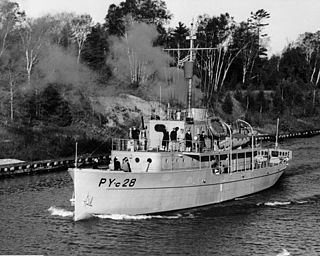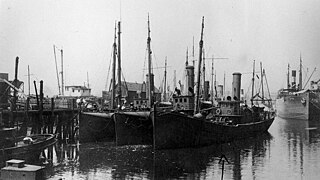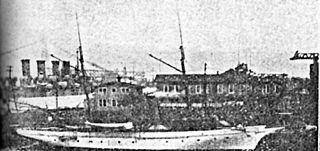
The first USS Ability (PYc-28) was a yacht in the service of the United States Navy used for anti-submarine warfare during World War II.

USS Impetuous (PYc-46) was a private yacht purchased by the Navy in August 1940 that served as a patrol boat of the United States Navy in Central America. The yacht was built as Paragon, the first of at least two Davol yachts to bear the name, in 1915 for Charles J. Davol of Providence, Rhode Island. In 1916 Davol sold the yacht to John Fred Betz, 3d of Philadelphia who renamed the yacht Sybilla III which served as the Section Patrol yacht USS Sybilla III (SP-104) from May 1917 to December 1918. Sybilla III remained in Betz's ownership until sale in 1935 to R. Livingston Sullivan of Philadelphia who renamed the yacht Arlis. On 12 August 1940 the Navy purchased the yacht placing it in commission as USS PC-454 on 16 October. The vessel was given the name Impetuous and reclassified PYc-46 on 15 July 1943. The yacht was decommissioned at Philadelphia 31 August 1944 and transferred to the War Shipping Administration for sale.
USS Leader (PYc-42) was a Leader-class patrol boat acquired by the U.S. Navy for the task of patrolling coastal areas during World War II when there was the danger of enemy submarine activity.

USS Sturdy (PC-460/PYc-50) was a yacht converted to a patrol boat acquired by the U.S. Navy for the task of patrolling the coastal waters of the U.S. East Coast during World War II. Her primary task was to guard the coastal area against German submarines.
USS Venture (PC-826/PYc-51) was a patrol boat acquired by the U.S. Navy for the task of patrolling the coastal waters of the New York coast during World War II. Her primary task was to guard the coastal area against German submarines. For this reason, she carried depth charges.

USS Kanawha II (SP-130), later called USS Piqua (SP-130), was a steam yacht that was built in 1899, and which the United States Navy used as an armed yacht in the First World War. She was commissioned in 1917 as Kanawha II, with the "II" added probably to distinguish her from the oiler USS Kanawha (AO-1). She was renamed Piqua in 1918, probably for the same reason.

An armed yacht was a yacht that was armed with weapons and was typically in the service of a navy. The word "yacht" was originally applied to small, fast and agile naval vessels suited to piracy and to employment by navies and coast guards against smugglers and pirates. Vessels of this type were adapted to racing by wealthy owners. The origin of civilian yachts as naval vessels, with their speed and maneuverability, made them useful for adaptation to their original function as patrol vessels. In the United States Navy armed yachts were typically private yachts expropriated for government use in times of war. Armed yachts served as patrol vessels during the Spanish–American War and the World Wars. In the latter conflicts, armed yachts were used as patrol vessels, convoy escorts, and in anti-submarine duties. In the United States, yachts were purchased from their owners with the owners given an option to repurchase their yacht at the close of hostilities.

USS Felicia (SP-642) was a steam yacht acquired by the United States Navy during World War I. She was outfitted and armed by the Navy as a patrol craft, and was assigned to patrol the New England waters. Her task of protecting ships from German submarines was interrupted by her collision with a submarine. Post-war she was reconfigured to her civilian condition, and was sold in 1919.

USS Ionita (SP-388) was a yacht acquired by the U.S. Navy during World War I. Ionita was outfitted by the Navy as a patrol craft and reported to the Commander, 9th Naval District, headquartered at Lake Bluff, Illinois. Ionita patrolled the Detroit River and was struck by the Navy at war’s end.

The first USS Mustang (SP-36) was an armed yacht that served in the United States Navy as a patrol vessel from 1917 to 1919.
USS Sardonyx (PYc-12), formerly the yacht named Queen Anne (1928), was a patrol boat in the United States Navy during World War II.

USS Clarinda (SP-185), later YP-185, was an armed yacht that served in the United States Navy as a patrol vessel from 1917 to 1930.

The second USS Ripple (ID-2439) was a United States Navy trawler which served as a minesweeper and was in commission from 1918 to 1919.

George Lawley & Son was a shipbuilding firm operating in Massachusetts from 1866 to 1945. It began in Scituate, then moved to Boston. After founder George Lawley (1823–1915) retired in 1890, his son, grandson and great-grandson upheld the business, which continued until 1945. Of the hundreds of ships built by the Lawleys, highlights include the yachts Puritan and Mayflower, respective winners of the 1885 and 1886 America's Cup.

The third USS Seneca (SP-427), later USS SP-427, was a United States Navy minesweeper and patrol vessel in commission from 1917 to 1919.

USS Elfrida, later USS Elfrida (SP-988), was a United States Navy patrol vessel in commission from 1898 to 1918. She served in the Spanish–American War and World War I.

USS Liberty III (SP-1229), sometimes written Liberty # 3, and also referred to during her naval career as Liberty and as Pilot Boat Liberty, No. 3, was a United States Navy patrol vessel in commission from 1917 to 1919. The Liberty was a pilot boat from 1896-1917. She was a replacement for the pilot boat D. J. Lawlor. After World War I, the Liberty returned to pilot service until 1934 when she was purchased as a yacht.
John Rogers Maxwell, Jr. was the winner of the 1907 King's Cup with his yacht Queen.
USS Garnet (PYc-15) was a coastal patrol yacht in the service of the United States Navy.
USS Truant (PYc-14) was a coastal patrol yacht in the service of the United States Navy.














